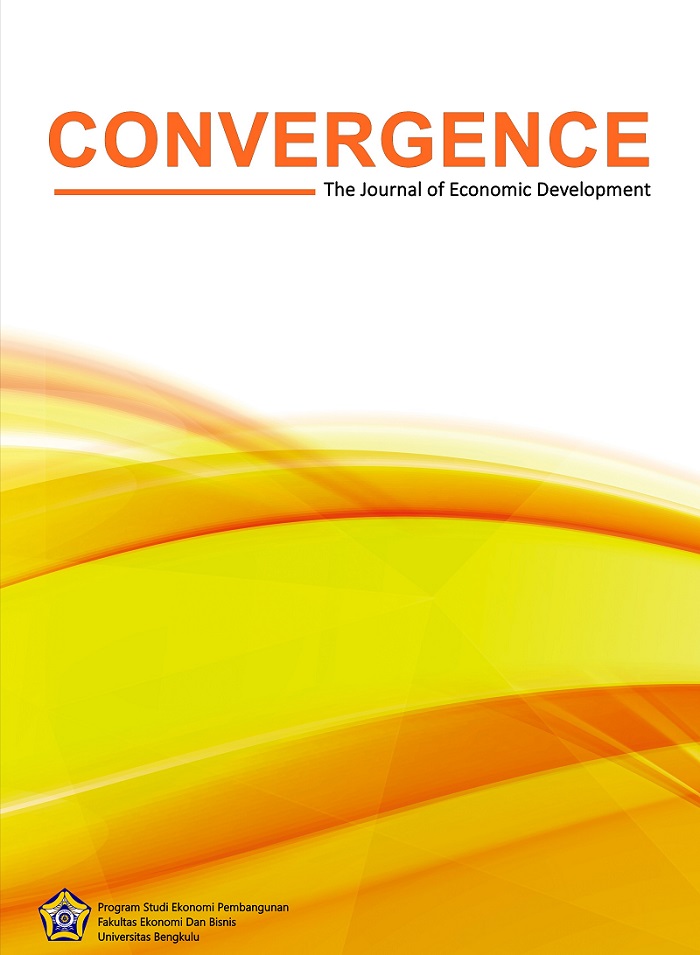Main Article Content
Abstract
This study aims to determine the characteristics of tilapia farmers in Sido Luhur Village, determine the level of income and sources of income of tilapia cultivator households, and determine the level of welfare of tilapia cultivator households. The method used in this study is descriptive qualitative, which is the characteristics of tilapia fishers, namely age, number of dependents, education level, business experience, pool area, and labor needed. To measure the level of welfare of tilapia cultivator households using measurements from the Central Agency for household welfare criteria based on BKKBN. The results of measurements of the level of well-being in the community of Sido Luhur Village, Padang Jaya Subdistrict, North Bengkulu Regency can be said to be prosperous, this is because tilapia farmers in general have met the criteria according to BKKBN indicators, because most of them have been able to fulfill their basic daily needs, as many as 33 respondents, which are in the third prosperous stratum, and according to research there are more tilapia farmers who are in the pre-prosperous category.
Keywords: Hight of Welfare, Income
Keywords
Article Details
- This statement is a commitment from the author, to respect copyright, both in terms of quoting the work of others, as well as in the use of journal content.
- If needed, the author can send a statement of authenticity of the manuscript. With the receipt of an article by the Editor of Convergence: The Journal of Economic Development, the article submitted has the copyright held by Convergence: The Journal of Economic Development Convergence:
- The Journal of Economic Development has the right to reproduce and distribute articles that have been published in journals.
- The author is not permitted to publish the same article that has been published in this journal.
References
- Badan Pusat Statistik Jakarta Pusat. 1998. Pendapatan dan Penerimaan Rumah Tangga 2003. Jakarta : BPS.
- Badan Pusat Statistik Jakarta Pusat. 2002. Pendapatan dan Penerimaan Rumah Tangga 2003. Jakarta : BPS.
- Badan Pusat Statistik. 2002. Survei Sosial Ekonomi Nasional (Susenas). Tahun 2010. Jakarta : BPS
- Kementrian Kelautan dan Perikanan (KKP). 2016. Fishing News Books Ltd. 238 hal
- Kementrian Kelautan dan Perikanan (KKP). 2016. Fishing News Books Ltd. 230 ,hal
- Mulyanah. 2005. Tingkat Kesejahteraan Rumah Tangga Pembudidaya Ikan di Desa’Bojong Jengkol, Kecamatan Ciampea, Kabupaten Bogor. Skripsi. Fakultas Perikanan dan Ilmu Kelautan. Institut Pertanian Bogor, Bogor.
- Ogunremi, Olatunji. 2016. Assessment of Awareness and Adoption of Fish Farming Technologies in Obio-Akpor Local Government Area of Rivers, Nigeria. The Journal of Agricultural Sciences Vol 11 (3) : 4-7. 3 Maret 2019, University of Ibadan, Nigeria.
- Olanike, Alawode. 2016. Effect of Catfish Production on Welfare of Smallholder Farmers in Osun State, Nigeria. Journal of Agribusiness and Rural Development Vol 45 (2) : 14-17. 2 Maret 2019, University of Limpopo, South Africa.
- Rosni. 2016. Analisis Tingkat Kesejahteraan Masyarakat Nelayan di Desa Dahari Selebar, Kecamatan Talawi, Kabupaten Batubara. Jurnal Unimed, Vol 09 (1) : 17. 28 Februari 2019, Universitas Negeri Medan, Sumatera Utara.
- Sutawijaya dkk. 2013. Analisis Tingkat Kesejahteraaan Rumah Tangga Petani Ikan Hias Air Tawar di Kelurahan Cipedak, Kecamatan Jagakarsa, Kota Madya Jakarta Selatan. Jurnal Agribisnis. P-ISSN 1979-0058 Vol 07 (1) : 2-5. 5 Maret 2019, UIN Syarif Hidayatullah, Jakarta.
- Syofian, Siregar. 2014. Metode Penelitian Kuantitatif. Jakarta : Kencana.
- Tjakrawiralaksana A. 1983. Usaha Tani. Direktorat Jenderal Pendidikan Dasar dan Menengah. Jakarta : Departement Pendidikan dan Kebudayaan.
- Todaro, Michael P. 2006. Pembangunan Ekonomi (edisi kesembilan, jilid 1). Jakarta:Erlangga.
References
Badan Pusat Statistik Jakarta Pusat. 1998. Pendapatan dan Penerimaan Rumah Tangga 2003. Jakarta : BPS.
Badan Pusat Statistik Jakarta Pusat. 2002. Pendapatan dan Penerimaan Rumah Tangga 2003. Jakarta : BPS.
Badan Pusat Statistik. 2002. Survei Sosial Ekonomi Nasional (Susenas). Tahun 2010. Jakarta : BPS
Kementrian Kelautan dan Perikanan (KKP). 2016. Fishing News Books Ltd. 238 hal
Kementrian Kelautan dan Perikanan (KKP). 2016. Fishing News Books Ltd. 230 ,hal
Mulyanah. 2005. Tingkat Kesejahteraan Rumah Tangga Pembudidaya Ikan di Desa’Bojong Jengkol, Kecamatan Ciampea, Kabupaten Bogor. Skripsi. Fakultas Perikanan dan Ilmu Kelautan. Institut Pertanian Bogor, Bogor.
Ogunremi, Olatunji. 2016. Assessment of Awareness and Adoption of Fish Farming Technologies in Obio-Akpor Local Government Area of Rivers, Nigeria. The Journal of Agricultural Sciences Vol 11 (3) : 4-7. 3 Maret 2019, University of Ibadan, Nigeria.
Olanike, Alawode. 2016. Effect of Catfish Production on Welfare of Smallholder Farmers in Osun State, Nigeria. Journal of Agribusiness and Rural Development Vol 45 (2) : 14-17. 2 Maret 2019, University of Limpopo, South Africa.
Rosni. 2016. Analisis Tingkat Kesejahteraan Masyarakat Nelayan di Desa Dahari Selebar, Kecamatan Talawi, Kabupaten Batubara. Jurnal Unimed, Vol 09 (1) : 17. 28 Februari 2019, Universitas Negeri Medan, Sumatera Utara.
Sutawijaya dkk. 2013. Analisis Tingkat Kesejahteraaan Rumah Tangga Petani Ikan Hias Air Tawar di Kelurahan Cipedak, Kecamatan Jagakarsa, Kota Madya Jakarta Selatan. Jurnal Agribisnis. P-ISSN 1979-0058 Vol 07 (1) : 2-5. 5 Maret 2019, UIN Syarif Hidayatullah, Jakarta.
Syofian, Siregar. 2014. Metode Penelitian Kuantitatif. Jakarta : Kencana.
Tjakrawiralaksana A. 1983. Usaha Tani. Direktorat Jenderal Pendidikan Dasar dan Menengah. Jakarta : Departement Pendidikan dan Kebudayaan.
Todaro, Michael P. 2006. Pembangunan Ekonomi (edisi kesembilan, jilid 1). Jakarta:Erlangga.
